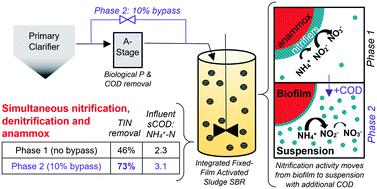当前位置:
X-MOL 学术
›
Environ. Sci.: Water Res. Technol.
›
论文详情
Our official English website, www.x-mol.net, welcomes your feedback! (Note: you will need to create a separate account there.)
Optimization of the carbon to nitrogen ratio for mainstream deammonification and the resulting shift in nitrification from biofilm to suspension
Environmental Science: Water Research & Technology ( IF 5 ) Pub Date : 2020-10-20 , DOI: 10.1039/d0ew00652a Paul Roots 1, 2, 3, 4 , Alex F. Rosenthal 1, 2, 3, 4 , Quan Yuan 1, 2, 3, 4 , Yubo Wang 1, 2, 3, 4 , Fenghua Yang 4, 5, 6 , Joseph A. Kozak 4, 5, 6 , Heng Zhang 4, 5, 6 , George F. Wells 1, 2, 3, 4
Environmental Science: Water Research & Technology ( IF 5 ) Pub Date : 2020-10-20 , DOI: 10.1039/d0ew00652a Paul Roots 1, 2, 3, 4 , Alex F. Rosenthal 1, 2, 3, 4 , Quan Yuan 1, 2, 3, 4 , Yubo Wang 1, 2, 3, 4 , Fenghua Yang 4, 5, 6 , Joseph A. Kozak 4, 5, 6 , Heng Zhang 4, 5, 6 , George F. Wells 1, 2, 3, 4
Affiliation

|
Application of the deammonification process to mainstream wastewater promises energy-efficient nitrogen removal, but has been limited by unwanted activity of nitrite oxidizing bacteria and low anammox activity at moderate temperatures (<20 °C). In the present study, N removal in a mainstream integrated fixed-film activated sludge (IFAS) deammonification process increased by 27% to 73% total inorganic nitrogen (TIN) removal by diverting 10% of the primary effluent flow around the A-stage and directly into the deammonification reactor, thereby increasing the influent C : N ratio from 2.3 to 3.1 g sCOD/g NH4+-N. This change coincided with a dramatic shift in nitrification activity from the biofilm to the suspension, and the increased carbon enabled a higher suspended solids concentration at a realistic solids retention time of 7.3 ± 2.1 days. Anammox biomass and activity was retained over the entire study (>3 years) and was not negatively impacted by the increase in influent carbon. N isotope testing indicated that cross feeding between denitrifiers and anammox played an important role in N removal and that about 53% of N removal was ultimately routed through the anammox metabolism. The reactor temperature was controlled near 20 °C for most of the study, and 72% TIN removal was maintained during a temperature decline down to 12 °C (after which TIN removal reduced to an average of 58% from 12 down to 8 °C). Our work demonstrates the impact of small changes in C : N on performance, population structure, and aggregate type (biofilm vs. floc) in mainstream deammonification bioprocesses and provides a simple approach to control C : N in practice.
中文翻译:

优化碳氮比,实现主流脱氨作用,以及硝化作用从生物膜转移到悬浮液的过程
将脱氨工艺应用于主流废水有望实现能源高效的脱氮,但受到亚硝酸盐氧化细菌的有害活性和在中等温度(<20°C)下较低的厌氧氨氧化活性的限制。在本研究中,主流化的固定膜活性污泥(IFAS)脱氨工艺中的N去除通过将A级和左右一级废水的10%转移,使总无机氮(TIN)去除率提高了27%至73%。直接将其加入脱氨反应器中,从而将进水的C:N比从2.3 g sCOD / g NH 4 +增加到3.1 g-N。这种变化与硝化活性从生物膜到悬浮液的急剧变化相吻合,并且碳的增加使得在实际的固体保留时间为7.3±2.1天时,悬浮物的浓度更高。厌氧氨氧化生物量和活性在整个研究(> 3年)中均得到保留,并且不受进水碳增加的负面影响。氮同位素测试表明,反硝化器和厌氧氨氮之间的交叉进料在氮的去除中起着重要作用,并且最终约有53%的氮去除最终通过厌氧氨氮代谢进行。在大多数研究中,将反应器温度控制在20°C附近,并且在温度下降至12°C的过程中,TIN的去除率保持在72%(此后,TIN的去除率从12°C降至8°C降至平均58% )。与絮凝剂相比)在主流脱氨生物工艺中提供了实用的控制C:N的简单方法。
更新日期:2020-11-03
中文翻译:

优化碳氮比,实现主流脱氨作用,以及硝化作用从生物膜转移到悬浮液的过程
将脱氨工艺应用于主流废水有望实现能源高效的脱氮,但受到亚硝酸盐氧化细菌的有害活性和在中等温度(<20°C)下较低的厌氧氨氧化活性的限制。在本研究中,主流化的固定膜活性污泥(IFAS)脱氨工艺中的N去除通过将A级和左右一级废水的10%转移,使总无机氮(TIN)去除率提高了27%至73%。直接将其加入脱氨反应器中,从而将进水的C:N比从2.3 g sCOD / g NH 4 +增加到3.1 g-N。这种变化与硝化活性从生物膜到悬浮液的急剧变化相吻合,并且碳的增加使得在实际的固体保留时间为7.3±2.1天时,悬浮物的浓度更高。厌氧氨氧化生物量和活性在整个研究(> 3年)中均得到保留,并且不受进水碳增加的负面影响。氮同位素测试表明,反硝化器和厌氧氨氮之间的交叉进料在氮的去除中起着重要作用,并且最终约有53%的氮去除最终通过厌氧氨氮代谢进行。在大多数研究中,将反应器温度控制在20°C附近,并且在温度下降至12°C的过程中,TIN的去除率保持在72%(此后,TIN的去除率从12°C降至8°C降至平均58% )。与絮凝剂相比)在主流脱氨生物工艺中提供了实用的控制C:N的简单方法。



























 京公网安备 11010802027423号
京公网安备 11010802027423号